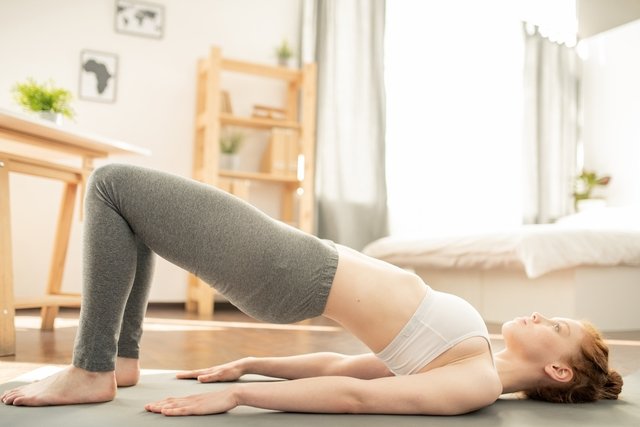Exercises for urinary incontinence, such as Kegel exercises or hypopressive exercises, are a great way to strengthen the pelvic floor muscles, also improving the function of the urethral sphincters, helping to combat urinary incontinence.
To be able to control urinary incontinence by performing these exercises, it is necessary to perform contractions correctly, every day, and results can be obtained in approximately 1 month, however, the complete treatment time can vary from approximately 6 months to 1 year.
These exercises can be performed in the case of female or male urinary incontinence, and must be performed under the guidance of a physiotherapist. Learn how to identify urinary incontinence.
Watch the following video with tips on how to do exercises for urinary incontinence:
The most recommended exercises for urinary incontinence are:
1. Kegel Exercises
Kegel exercises are recommended for urinary incontinence, because they help to strengthen the muscles in the pelvic region and increase blood circulation in the area.
To do Kegel exercises correctly, you first need to identify the perineum muscle. To do this, you must empty the bladder, interrupting the stream of urine, thus trying to identify the muscle that is used in the process. Then, to start the exercises correctly, it is important:
- Do 10 contractions in a row and stop;
- Repeat the contractions in order to do at least 3 complete series;
- Repeat the series 2 to 3 times a day. In total, it is recommended to do at least 100 contractions per day, but it is not recommended to do everything at once, because the pelvic floor muscles get tired very easily.
After approximately 15 days to 1 month, you can progress by performing the exercise more difficult. To do this, simply hold each contraction for about 10 seconds. The complete series consists of doing at least 20 sustained contractions, at 2 different times of the day, in the morning and late afternoon, for example.
Although it is a simple exercise that can be done anytime and anywhere, the ideal is to set a time of day to do it, as this makes it easier to complete the series until the end.
This exercise can be performed in a sitting, lying or standing position, however, it is recommended to start lying down, as it is easier to perform the exercises. With practice, it is normal to want to make contractions faster, but this should not happen, because ideally, each contraction should be well controlled so that it has the expected effect.
2. Hypopressive abdominals
Hypopressive sit-ups allow the muscles of the perineum to be “sucked” upwards, repositioning the bladder and strengthening the ligaments that support it, being very useful for combating urinary incontinence. Furthermore, this type of exercise also helps control fecal incontinence and prevent uterine prolapse.
To perform hypopressive abdominal exercises to treat involuntary loss of urine, you must:
- Lie on your back with your knees bent and your arms at your sides;
- Completely empty your lungs, exhaling forcefully until your abdomen begins to contract on its own;
- After eliminating all the air, ‘suck’ your belly in, as if you wanted to touch your navel to your back;
- Maintain this position without breathing for 10 to 30 seconds or for as long as you can go without breathing.
During this ‘sucking’ of the belly, the muscles of the perineum must also contract, elevating all the organs inwards and upwards as much as possible, as if the person wanted them all to be stored behind the ribs.
It is important that these exercises are always performed with an empty bladder, to avoid cystitis, which is an inflammation of the bladder caused by the accumulation of microorganisms inside it. The objective of these exercises is to restore muscle tone and strength to the perineum and the entire pelvic floor, preventing urine loss and even improving intimate contact.
3. Pilates
Pilates exercises help to strengthen the pelvic floor muscles, increasing their strength and endurance, which helps to better control the bladder muscles and urinary sphincters, reducing involuntary urine loss.
These exercises can be performed on the floor and have low impact, and can be performed daily to obtain the benefits in controlling urine, preferably with guidance from a physiotherapist specializing in Pilates.
To do Pilates exercises for urinary incontinence, you must:
- Lie on a gym mat, face up;
- Cross your legs, keeping them stretched;
- Stretch your arms, keeping them aligned with your body;
- Inhale slowly and raise your straight legs, approximately 5 cm from the floor;
- Exhale slowly and raise your torso, with your abdomen contracted, as if you were going to do a sit-up;
- Maintain this position and swing your arms up and down, at your sides, making short movements, always with your abdomen contracted;
- Swing your arms around 20 times and return to the starting position. Repeat this exercise 2 to 3 times.
This exercise can be started by making 20 arm movements, and gradually increased from 5 to 5, until you can make 100 arm movements.
It is recommended that Pilates be practiced regularly, as this ensures the benefits in controlling urine and promoting quality of life.
4. Yoga
Yoga exercises help to improve resistance and strengthen the pelvic muscles and perineum, helping to control involuntary loss of urine, as well as relieving anxiety and stress, which can worsen urinary incontinence in the case of overactive bladder.
The most recommended Yoga exercise for urinary incontinence is Mula Bandha, and to perform it you must:
- Sit on the floor on a gym mat, with your spine straight and legs crossed, as if it were the butterfly position used in ballet;
- Inhale deeply, counting to 5, and contract your pelvic muscles as if bringing them above your chest;
- Maintain this position for approximately 30 seconds;
- Exhale slowly, counting to 5, relaxing your pelvic floor muscles slowly and gradually, until you return to the starting position.
This exercise can be done daily, for 5 minutes, twice a day, preferably with guidance from a physiotherapist or a professional specialized in Yoga.
5. Ponte
The bridge is an exercise that helps to strengthen the abdomen, glutes and thighs, but also helps to stabilize and strengthen the pelvic floor, and in this way, helps to control urinary incontinence.
To make the bridge, you must:
- Lie on the floor face up, on a yoga mat, for example, with your arms aligned with your body;
- Bend your knees and place your feet on the floor;
- Contract your pelvis, abdomen and glutes and raise your hips off the floor, without touching your butt to the floor;
- Maintain this position for 10 seconds;
- Relax your pelvic floor and gluteal muscles, and slowly lower your hips until they touch the floor.
You can start with a series of 8 to 10 repetitions and over time increase the number of series to 2 to 3.
6. Squats
Squats are a complete exercise that works the glutes, thighs, calves, back of the legs and abdomen, and also helps to strengthen the pelvic floor, for both women and men, helping to control urinary incontinence.
However, for people who have back or knee pain, this exercise is not recommended.
To do squats, you must:
- Standing, feet apart, shoulder-width apart. The back should always remain straight and the abdomen contracted;
- Slowly descend by bending your knees, leaning your torso slightly forward and pushing your butt far back, as if you were going to sit on an invisible chair;
- Go down until your knees are at a 90-degree angle and do not extend beyond your toes;
- Return to the starting position, contracting your glutes and pelvic floor.
You can start with 1 set of 10 repetitions and increase over time to up to 3 sets, with 1 minute of rest between sets.

Sign up for our newsletter and stay up to date with exclusive news
that can transform your routine!
Warning: Undefined array key "title" in /home/storelat/public_html/wp-content/plugins/link-whisper-premium/templates/frontend/related-posts.php on line 12
Warning: Undefined array key "title_tag" in /home/storelat/public_html/wp-content/plugins/link-whisper-premium/templates/frontend/related-posts.php on line 13




